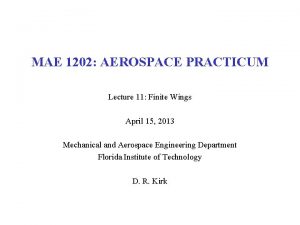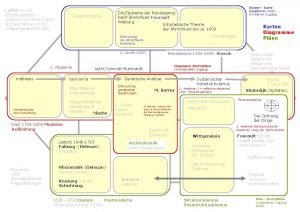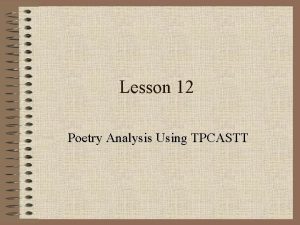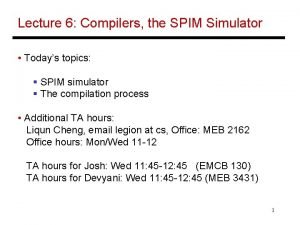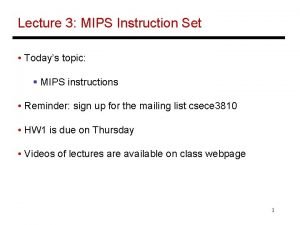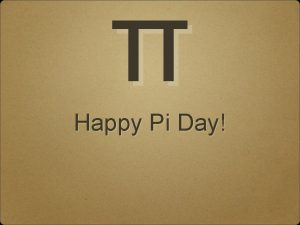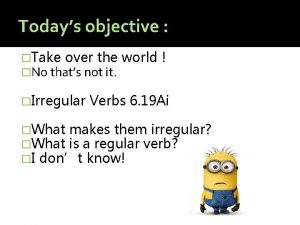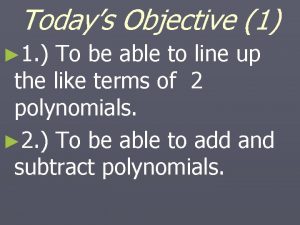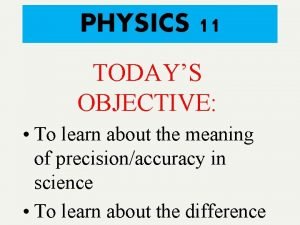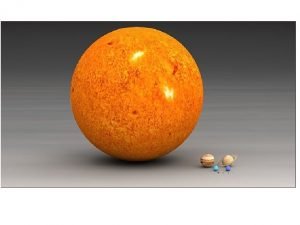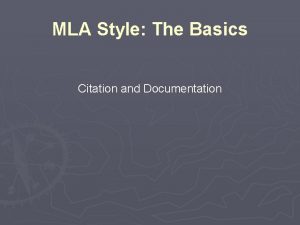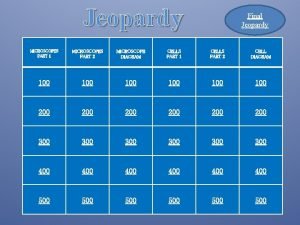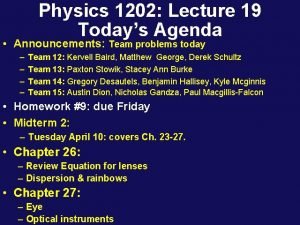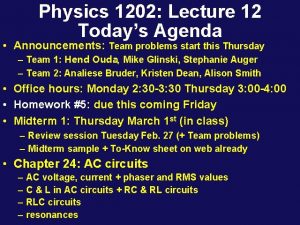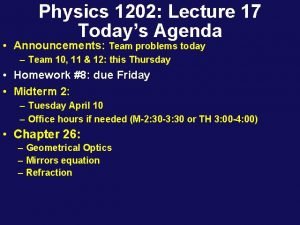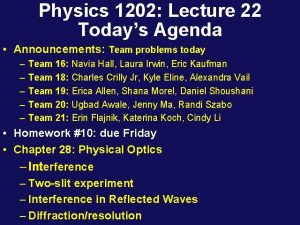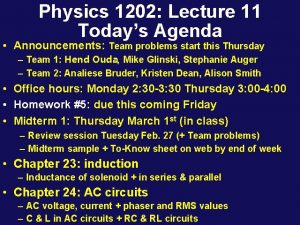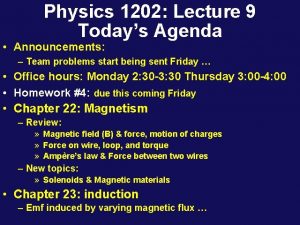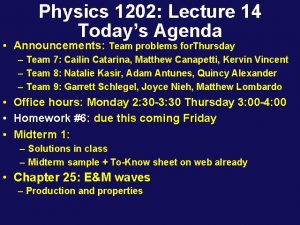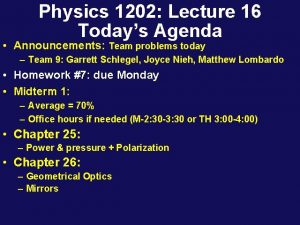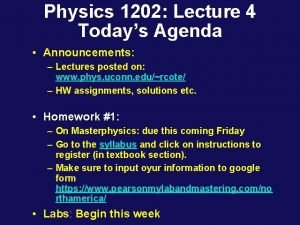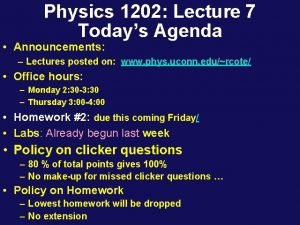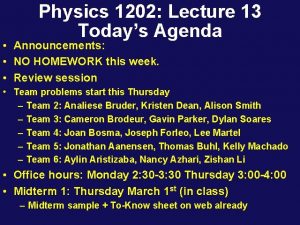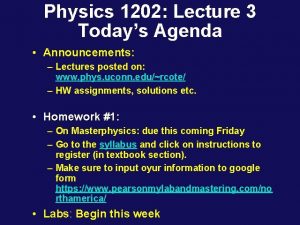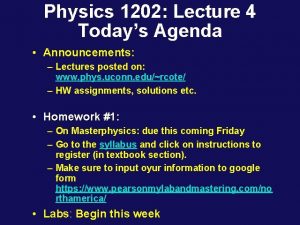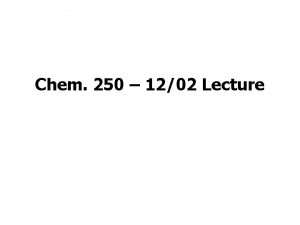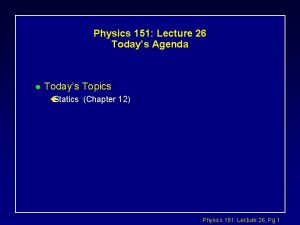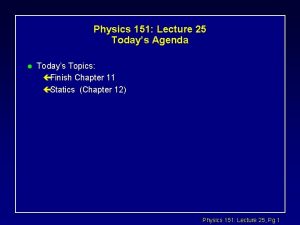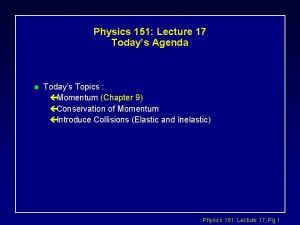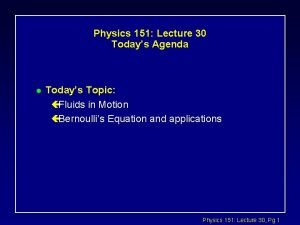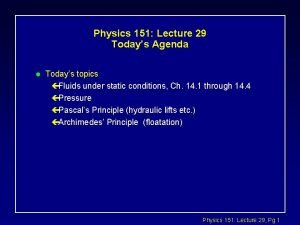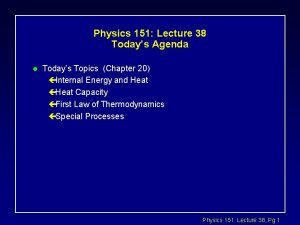Physics 1202 Lecture 8 Todays Agenda Announcements Team











































- Slides: 43

Physics 1202: Lecture 8 Today’s Agenda • Announcements: – Team problems start being sent Friday … • Office hours: – Monday 2: 30 -3: 30 – Thursday 3: 00 -4: 00 • Homework #3: due this coming Friday • Labs: Already begun • Policy on clicker questions – 80 % of total points gives 100% – No make-up for missed clicker questions … • Policy on Homework – Lowest homework will be dropped – No extension

Today’s Topic : • Chapter 22: Magnetism – Magnetic field (B) & force – Motion of a charged particle in B-field • New topics: – – – Force on current carrying wire Froce and torque on a loop Ampère’s law Force between two wires Solenoids Magnetic materials


22 -2: Forces due to Magnetic Fields • Magnets exert forces on other magnets. • Also, B provides a force to a charged particle, but this force is in a direction perpendicular to the direction of the magnetic field. Right Hand Rule:

22 -3: motion of a charges particle • Consider a positive charge • in an electric field – force in the direction of field E • in a magnetic field – force is perpendicular to field B • This leads to very different motions • Because Fmag is perpendicular to the direction of motion, the path of a particle is circular • Also, while E can do work on a particle, B cannot—the particle’s speed remains constant © 2017 Pearson Education, Inc.

Circular motion • Force is perp. to v • q = 90 o so sinq = 1 or F=qv. B • Work proportional to cos f (recall 1201) ⎼ f : angle between F and Dx – cos f =0 (perpendicular) • W=0 Þ DK=0 – Kinetic energy not changed – Velocity constant: UCM ! R

Lecture 8, ACT 1 • Cosmic rays (atomic nuclei stripped bare of their electrons) would continuously bombard Earth’s surface if most of them were not deflected by Earth’s magnetic field. Given that Earth is, to an excellent approximation, a magnetic dipole, the intensity of cosmic rays bombarding its surface is greatest at the (The rays approach the earth radially from all directions). A) Poles B) Equator C) Mid-lattitudes

Motion of Charged Particles • If a v makes an angle with B – the component of v along B will not change – a particle with initial v at an angle to B will move in a helical path.

Trajectory in Constant B Field • Suppose charge q enters B field with velocity v as shown below. (v B) What will be the path q follows? x x x x x x v x B x x x v F q F R • Force is always to velocity and B. What is path? – Path will be circle. F will be the centripetal force needed to keep the charge in its circular orbit. Calculate R:

Radius of Circular Orbit • Lorentz force: • centripetal acc: • Newton's 2 nd Law: x x x x B x x x x x x v F F q R Þ Þ This is an important result, with useful experimental consequences !

Ratio of charge to mass for an electron e- 1) Turn on electron ‘gun’ 2) Turn on magnetic field B R DV ‘gun’ 3) Calculate B … next week; for now consider it a measurement 4) Rearrange in terms of measured values, V, R and B & Þ

The Hall Effect l Force balance c B I vd F - d c q. EH B I Hall voltage generated across the conductor a Using the relation between drift velocity and current we can write:

22 -4: Magnetic Force on a Current • Consider a current-carrying wire in the presence of a magnetic field B. • There will be a force on each of the charges moving in the wire. What will be the total force DF on a length Dl of the wire? • Suppose current is made up of n charges/volume each carrying charge q and moving with velocity v through a wire of crosssection A. • Force on each charge = • Total force = Þ • Current = Simpler: For a straight length of wire L carrying a current I, the force on it is: or N S


Lecture 8, ACT 2 y • A current I flows in a wire which is formed in the shape of an isosceles triangle as shown. A constant magnetic field exists in the -z direction. – What is Fy, net force on the wire in the ydirection? (a) Fy < 0 (b) Fy = 0 (c) Fy > 0 x

22 -5: Fmag on a Current Loop • Consider loop in magnetic field as on right: If field is to plane of loop, the net force on loop is 0! – Force on top path cancels force on bottom path (F = IBL) x x Fx x x x – Force on right path cancels force on left path. (F = IBL) • If plane of loop is not to field, there will be a non-zero torque on the loop! F x x x x x ix F x x x B x x F x B x F F.

Calculation of Torque • Suppose a square wire loop has width w (the side we see) and length L (into the screen). The torque is given by: B q x w F Þ . Þ since: A = w. L = area of loop • Note: if loop B, sinq = 0 Þ t = 0 maximum t occurs when loop parallel to B F r rx. F q F

Magnetic Dipole Moment • We can define the magnetic dipole moment of a current loop as follows: magnitude: B m=AI direction: to plane of the loop q in the direction the thumb of right hand points if fingers curl in direction of current. • Torque on loop can then be rewritten as: t = A I B sinq Þ • Note: if loop consists of N turns, m = N A I x w F m F q .

Lecture 8, ACT 3 A rectangular loop is placed in a uniform magnetic field with the plane of the loop parallel to the direction of the field. If a current is made to flow through the loop in the sense shown by the arrows, the field exerts on the loop: A) a net force. B) a net torque. C) a net force and a net torque. D) neither a net force nor a net torque.

Lecture 8, ACT 4 • A circular loop of radius R carries current I as shown in the diagram. A constant magnetic field B exists in the +x direction. Initially the loop is in the x-y plane. – The coil will rotate to which of the following positions? (a) (b) (c) It will not rotate

22 -6: Electric current & B-Field • A current-carrying wire produces a magnetic field • The compass needle deflects in directions tangent to the circle �The compass needle points in the direction of the magnetic field produced by the current Hans Christian Oersted 1777 – 1851 Best known for observing that a compass needle deflects when placed near a wire carrying a current First evidence of a connection between electric and magnetic phenomena

22 -6: Electric current & B-Field • To find the direction of B due to I – point the thumb of your right hand along the wire in the direction I – Your fingers are now curling around the wire in the direction of B © 2017 Pearson Education, Inc.

Magnetic Field of ¥ Straight Wire Experimentally Direction of B: right-hand rule

22 -6 Ampère’s Law • Ampère’s law relates the current through a surface defined by a closed path to the magnetic field along the path:

22 -6: Calculation of Magnetic Field • Two ways to calculate the Magnetic Field: • Biot-Savart Law: ´I "Brute force" • Ampère's Law "High symmetry" • These are the analogous equations for the Magnetic Field! 0= 4 X 10 -7 T m /A: permeability (vacuum)

22 -6 Ampère’s Law for straight wire • Use Ampère’s law to find the magnetic field around a long, straight wire • B always parallel to circle • Constant magnitude on circle Þ

Force between 2 wires • B due to wire 2: • Force on wire 1 due to B of wire 2: • Total force between wires 1 and 2: • Direction: attractive for I 1, I 2 same direction repulsive for I 1, I 2 opposite direction

Lecture 8, ACT 5 • I have two wires, labeled 1 and 2, carrying equal current, into the page. We know that wire 1 produces a magnetic field, and that wire 2 has moving charges. What is the force on wire 2 from wire 1 ? Wire 1 Wire 2 X X I F I B (a) Force to the right (b) Force to the left (c) Force = 0

Circular Loop > • Symmetry Þ B in z-direction. I • Rq > • Circular loop of radius R carries current i. Calculate B along the axis of the loop: R Þ x r DB q z r DB • At the center (z=0): z>>R: • Note the form the field takes for z>>R: for N coils z

Lecture 8, ACT 6 • Equal currents I flow in identical circular loops as shown in the diagram. The loop on the right (left) carries current in the ccw (cw) direction as seen looking along the +z direction. – What is the magnetic field Bz(A) at point A, the midpoint between the two loops? (a) Bz(A) < 0 (b) Bz(A) = 0 (c) Bz(A) > 0

Lecture 8, ACT 7 • Equal currents I flow in identical circular loops as shown in the diagram. The loop on the right (left) carries current in the ccw (cw) direction as seen looking along the +z direction. – What is the magnetic field Bz(B) at point B, just to the right of the right loop? (a) Bz(B) < 0 (b) Bz(B) = 0 (c) Bz(B) > 0


B Field of a Solenoid • A constant magnetic field can (in principle) be produced by an ¥ sheet of current. In practice, however, a constant magnetic field is often produced by a solenoid. L • A solenoid is defined by a current I flowing through a wire which is wrapped n turns per unit length on a cylinder of radius a and length L. • If a << L, the B field is to first order contained within the solenoid, in the axial direction, and of constant magnitude. In this limit, we can calculate the field using Ampere's Law. a



B Field of a ¥ Solenoid • To calculate the B field of the ¥ solenoid using Ampere's Law, we need to justify the claim that the B field is 0 outside the solenoid. • To do this, view the ¥ solenoid from the side as 2 ¥ current sheets. • The fields are in the same direction in the region between the sheets (inside the solenoid) and cancel outside the sheets (outside the solenoid). Þ xxxxx • • • (n: number of turns per unit length)


Toroid • Toroid defined by N total turns with current i. • B=0 outside toroid! • • Þ • • xx x x xx • • B inside the toroid. • • • x x r xx xx • B • •

Magnetic Materials • An individual atom should act like a magnet because of the motion of the electrons about the nucleus – Each electron circles the atom once in about every 10 -16 seconds – This would produce a current of 1. 6 m. A and a magnetic field of about 20 T at the center of the circular path • However, the magnetic field produced by one electron in an atom is often canceled by an oppositely revolving electron in the same atom unmagnetized domain

Magnetism in Matter • When a substance is placed in an external magnetic field Bo, the total magnetic field B is a combination of Bo and field due to magnetic moments (Magnetization; M): – B = Bo + mo. M = mo (H +M) = mo (H + c H) = mo (1+c) H » where H is magnetic field strength c is magnetic susceptibility • Alternatively, total magnetic field B can be expressed as: – B = mm H » where mm is magnetic permeability » mm = mo (1 + c ) • All the matter can be classified in terms of their response to applied magnetic field: – Paramagnets – Diamagnets – Ferromagnets mm > mo mm < mo mm >>> mo

Problem Solution Method: Five Steps: 1) Focus on the Problem - draw a picture – what are we asking for? 2) Describe the physics - what physics ideas are applicable what are the relevant variables known and unknown 3) Plan the solution - what are the relevant physics equations 4) Execute the plan - solve in terms of variables solve in terms of numbers 5) Evaluate the answer - are the dimensions and units correct? do the numbers make sense?

Types of Magnetic Materials • Ferromagnetic – Have permanent magnetic moments that align readily with an externally applied magnetic field – (Fe, Ni, Co, Gd, Dy, and compounds) • Paramagnetic – Have magnetic moments that tend to align with an externally applied magnetic field, but the response is weak compared to a ferromagnetic material – (Al, O, Ca, Pt, W, …) • Diamagnetic – An externally applied field induces a very weak magnetization that is opposite the direction of the applied field – (Cu, Ag, Si, N, diamond, …)

Recap of Today’s Topic : • Chapter 22: Magnetism – Magnetic field (B) & force – Motion of a charged particle in B-field • New topics: – – – Force on current carrying wire Froce and torque on a loop Ampère’s law Force between two wires Solenoids Magnetic materials
 Delta flight 1202
Delta flight 1202 +1316
+1316 Design and fabrication 1202
Design and fabrication 1202 Todays agenda
Todays agenda Pvu announcement
Pvu announcement R/announcements
R/announcements Church announcements
Church announcements What happened when montag crossed the ten-lane highway?
What happened when montag crossed the ten-lane highway? Kluver bucy syndrome
Kluver bucy syndrome General announcements
General announcements 01:640:244 lecture notes - lecture 15: plat, idah, farad
01:640:244 lecture notes - lecture 15: plat, idah, farad Agenda sistemica y agenda institucional
Agenda sistemica y agenda institucional The standard agenda
The standard agenda Physics 111 lecture notes
Physics 111 lecture notes Physics 101 lecture
Physics 101 lecture Phy101 lecture 1
Phy101 lecture 1 Physics 101 lecture notes pdf
Physics 101 lecture notes pdf Waves physics notes pdf
Waves physics notes pdf Atmospheric physics lecture notes
Atmospheric physics lecture notes Team spirit becomes team infatuation
Team spirit becomes team infatuation Team spirit becomes team infatuation
Team spirit becomes team infatuation The white team cheers for the blue team, just like
The white team cheers for the blue team, just like Todays generations
Todays generations Today's classes
Today's classes Todays with apostrophe
Todays with apostrophe Todays worldld
Todays worldld Whats todays temperature
Whats todays temperature Todays globl
Todays globl Whats todays wordlw
Whats todays wordlw Chapter 13 marketing in todays world
Chapter 13 marketing in todays world Todays plan
Todays plan Todays sabbath lesson
Todays sabbath lesson 25 creative ideas for sabbath school
25 creative ideas for sabbath school Veseyans rfc
Veseyans rfc Todays health
Todays health Todays objective
Todays objective Todays objective
Todays objective Todays objective
Todays objective Todays whether
Todays whether Todays vision
Todays vision Todays objective
Todays objective Planetary positions today
Planetary positions today Todays date in mla format
Todays date in mla format Todays final jeopardy answer
Todays final jeopardy answer
